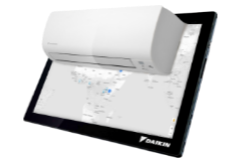
Ventilation equipment is operated either
- By a tenant company employee with a remote controller, or
- By a building management company exclusively
 Check installed ventilation equipment
Check installed ventilation equipment
- Type of ventilation system installed?
- Location of ventilation system & vents
- Location of remote controller
Medium-sized Office


 Airflow entering from outdoors
Airflow entering from outdoors
 Airflow leaving from indoors
Airflow leaving from indoors
 Air conditioner only circulates the indoor air
Air conditioner only circulates the indoor air
① Remote controller switch
② Ventilation hood
③ Ventilation vent (exhaust)
④ Door vent
⑤ Vent / Vent cap
⑥ Heat reclaim ventilator

 Air conditioner
Air conditioner
 Air blower
Air blower
 Remote controller switch
Remote controller switch
 Ventilation vent (air exhaust)
Ventilation vent (air exhaust)
 Ventilation vent (air supply)
Ventilation vent (air supply)
Small-sized Office


 Airflow entering from outdoors
Airflow entering from outdoors
 Airflow leaving from indoors
Airflow leaving from indoors
 Air conditioner only circulates the indoor air
Air conditioner only circulates the indoor air
① Remote controller switch
② Ventilation hood
③ Ventilation vent (exhaust)
④ Door vent
⑤ Vent / Vent cap
⑥ Heat reclaim ventilator

 Air conditioner
Air conditioner
 Air blower
Air blower
 Remote controller switch
Remote controller switch
 Ventilation vent (air exhaust)
Ventilation vent (air exhaust)
 Ventilation vent (air supply)
Ventilation vent (air supply)
Regular cleaning and maintenance
Operation and maintenance of AC and ventilation equipment are done either
- By a building management company and a facility manager (medium sized offices), or
- By the office tenant companies themselves (small offices)
It is important to understand:
- The operation status of the ventilation equipment: i.e. operation times, airflow amount, etc.
- The cleaning schedule and maintenance status
Check, clean & replace filters
Filters are installed to the ventilation ducts behind the vents on the walls and ceilings.
When filters become clogged with dirt, ventilation efficiency decreases. You may not even notice that ventilation capacity has worsened.
It is important to regularly clean or replace filters and air ducts.
Never operate ventilation systems without filters. Filters prevent outside pollutants coming indoors and protect ventilation equipment.
- Filters should be inspected once per month for cleanliness and condition and replaced once a year.
Consult with an HVAC specialist on recommended periodic maintenance and inspection intervals to ensure long-life service and confidence for the heat reclaim ventilators.
If you have any problems in the operation, maintenance, or cleaning of the ventilation equipment, be sure to consult an HVAC specialist.
Create an air passage by opening windows and entrance doors
Using ventilation equipment together with opening windows and doors
Office layout and partitions often change, and the airflow assumed at system installation may not be suitable anymore for the current situation.
Uneven temperatures and air stagnation can easily occur.
In small or medium-sized offices, you can reliably and effectively change the air in buildings by using the ventilation equipment together with opening windows and entrance doors.
- Open windows for ~10 minutes every hour
The effect becomes even higher when ventilation is performed 2 times for 5 minutes every hour than with 10min once every hour.
We recommend ventilating before the start of business hours and during breaktimes.

- Create air passage
- Good example
- Bad example
- Difficulties

Open windows (and doors) to create an air passage
When ventilation is performed by opening windows, it is better to open 2 windows instead of 1 in order to create an air passage.
The effect is even better if the 2 windows are located diagonal to each other.
It is most efficient to open windows that are diagonal to each other


Opening 2 windows positioned close to each other will prevent air from flowing through the entire room.
Insufficient air circulation
Inefficiency results from opening nearby windows due to the small area in which air circulates.
Difficulties to create a breeze inside even when windows (and doors) are open?
When you feel that the airflow in the room is low
- Open the window supplying air only partially and
- Open the window discharging air much wider
A smaller opening for air supply causes air to flow more forcefully. This will increase ventilation efficiency. A narrow opening for the air inlet and wider opening for the air outlet helps mix the indoor air and ventilate the air over a larger area of the room.

Rooms without a window
When a room has no windows (e.g. a conference room), you need to first check the locations of the ventilation vents (air exhaust) on the ceiling. Opening the room door and placing fans or air circulators in the room will help send the flow of air outside the room.
Example ①:
Location of ventilation vent (air exhaust) is outside the conference room
When the ventilation vent (air exhaust) is outside the room, open the door and use a fan to send air OUTSIDE the room.
In this case, having either fans or air circulators both inside the conference room and just outside the door is more effective.

Example ②:
Location of the ventilation vent (air exhaust) is inside the conference room
When the ventilation vent (air exhaust) is inside the room/conference room, open the door and use a fan to send air INSIDE the room.

CO2 concentration in conference rooms
Closed conference rooms are especially susceptible to air stagnation.
In long or crowded meetings the CO2 concentration in the room quickly increases from the exhaled breath of each person. The CO2 build-up can lead to lapses in concentration and lower work performance.
To quickly ventilate a meeting room, operate the ventilation equipment together with opening the windows and doors.

Changes in CO2 concentration in a Conference Room
Check out our useful advice for:
FIND MY PRODUCT

DISCOVER OUR PRODUCTS
Navigate seamlessly through our ‘Find My Product’ section to explore a curated selection of tailored options, ensuring you identify the perfect match for your unique needs and preferences.
SALES NETWORK

NEARBY DAIKIN DEALERS
Explore our Sales Network across the MENA region to find nearby dealers, connect with trusted experts, and discover Daikin products and services designed to meet your requirements.
NEED HELP?

FOR ENQUIRIES AND SUPPORT
If you need assistance, have questions, or wish to explore potential partnerships, our dedicated team is always here to support you with a prompt, attentive, and personalized response.


